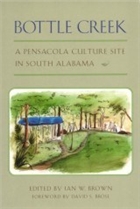The more I learn about the Mississippian period mound-building societies which once inhabited much of the Southeast, the more I am intrigued by them. Some of the most complex and largest prehistoric societies in world history, the Mississippians left us no written records and consequently can only be known through archaeology. Fortunately, they left us some great clues about where to dig, in the form of the remarkable mounds that were once the centerpieces of their sprawling cities. One of most intriguing of those communities in the Southeast is Alabama’s Bottle Creek Mound Site. Among the largest mound centers in the Southern U.S., the site is located in the heart of the Mobile-Tensaw delta in south Alabama. Ironically about a remote a spot as one can find today, at its height it is believed to have been the gateway for a sprawling chiefdom stretching from the Gulf to the Appalachians.
Mound sites such as Bottle Creek stir the imagination of those who love historic sites, but the literature on the discoveries archaeologists have made at them is inherently scientific, comprised overwhelmingly of reports and graphs and charts analyzing stacks of sherds, soil types, post holes and post molds, tiny bits of bone and corn remains, and charred ruins. Such is the case with Bottle Creek: A Pensacola Culture Site in South Alabama. The book features essays on various topics written by an all-star team of those who have worked with anything associated with the Bottle Creek site. In the usual dry, scientific reports it contains, the story of the amazing Bottle Creek site is buried. Reports demonstrate that life there from the 1300s to the 1500s conforms in large part to what is known of mound centers elsewhere in that the mounds were apparently the homes of the elite, supplied by farmsteads scattered throughout the region, and that the community in which they were located was the center of a substantial political, cultural, and economic network. Some things don’t quite line up, though, such as the fact that it was occupied later than many other regional sites, lending it an air of uniqueness and virtually demanding more study.

The most enjoyable part of the book is the summary provided by project editor Ian Brown, in which he ably brings together all the various bits of narrow inquiry contained in the book’s many short chapters to postulate on some wider hypotheses about this amazing site. These can’t be conclusively stated as fact, of course, but they are informed and interesting opinions that lean toward a conclusion that Bottle Creek was something of a sacred site, comparable to the famed Moundville in its influence, with an aura of respect among Native Americans that persisted centuries after its mysterious abandonment. Whatever original significance it had, Brown indicates, seemingly only grew in legend after the Mississippian societies that inhabited it collapsed and dispersed. Brown relates the story of Jean-Baptiste Le Moyne, Sieur de Bienville, founder of the city of Mobile, and his experience with the site in the early 1700s to illustrate his point. Bienville recorded in his journal having explored the area with local Indians and collected some European-manufactured items (likely dating to the De Soto era). The locals who guided him there dared not approach the mounds, choosing instead to take the Frenchmen to the site and staying a distance behind. The spot, they claimed, was “the place where there gods are.” For some reason that anecdote seems to tell me more about the Bottle Creek mounds and sites like it than all the graphs and charts contained in Bottle Creek. For now, though, the closest one can come to understanding the site and how its builders viewed it is this book, which brings together a great deal of recent scholarship and should enable us to create more informed visions of what life was like there. If you are interested in the Mississippian Period in the South, it is worthy of your attention.
JMB












